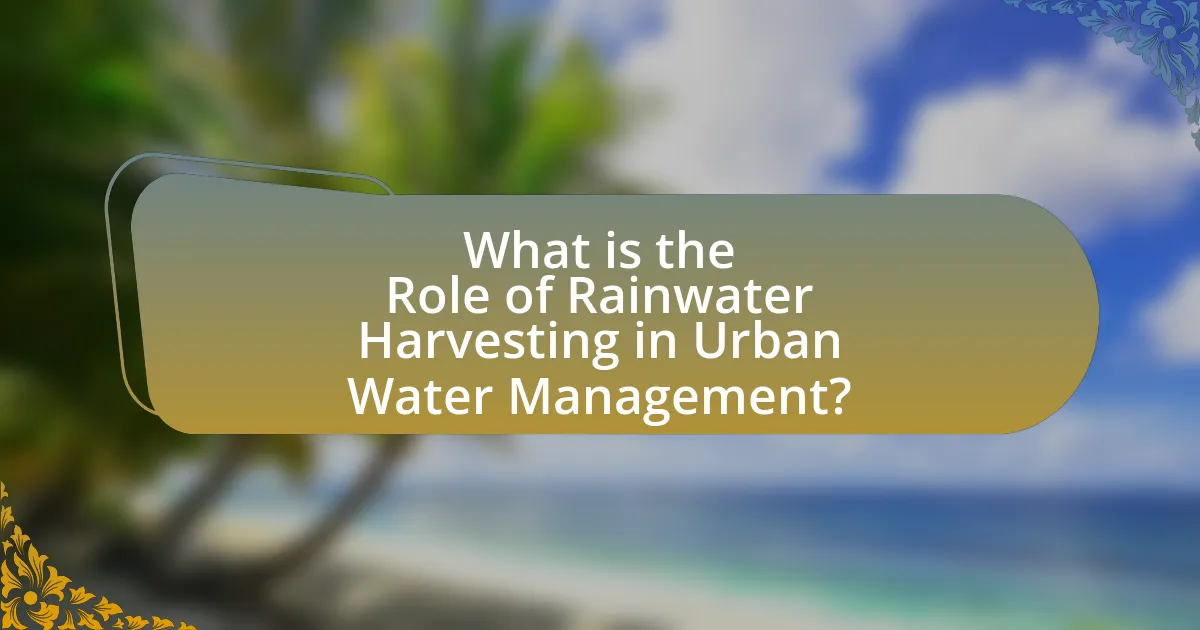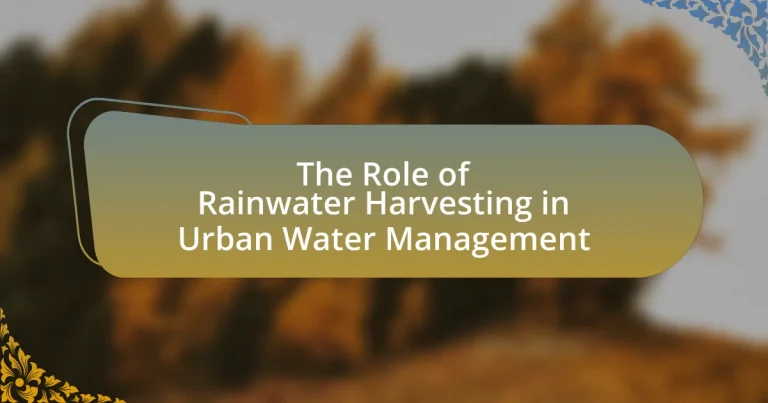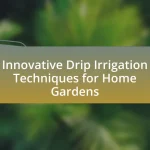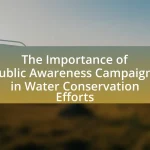Rainwater harvesting is a vital component of urban water management, offering a sustainable alternative to traditional water supply systems. This practice captures and stores rainwater for various applications, including irrigation and toilet flushing, thereby reducing the demand on municipal resources and mitigating urban flooding. Key elements of rainwater harvesting systems include catchment areas, storage tanks, and filtration units, which work together to enhance water availability and promote groundwater recharge. Despite its benefits, challenges such as regulatory barriers and public perception can hinder widespread adoption. The article explores the significance of rainwater harvesting in urban settings, its environmental advantages, and best practices for effective implementation.

What is the Role of Rainwater Harvesting in Urban Water Management?
Rainwater harvesting plays a crucial role in urban water management by providing a sustainable source of water that reduces reliance on traditional water supply systems. This practice captures and stores rainwater for various uses, such as irrigation, toilet flushing, and even potable water, thereby alleviating pressure on municipal water resources. According to the United Nations, urban areas can benefit from rainwater harvesting by improving water availability, enhancing flood control, and promoting groundwater recharge. In cities facing water scarcity, implementing rainwater harvesting systems can lead to a significant reduction in stormwater runoff, which in turn minimizes urban flooding and water pollution.
How does rainwater harvesting contribute to urban water supply?
Rainwater harvesting significantly enhances urban water supply by capturing and storing rainwater for various uses, thereby reducing reliance on traditional water sources. This method can supplement municipal water systems, especially in areas facing water scarcity, by providing an alternative source for irrigation, toilet flushing, and other non-potable uses. For instance, studies indicate that rainwater harvesting can reduce urban water demand by up to 30%, as demonstrated in cities like Sydney, where extensive rainwater systems have been implemented. Additionally, rainwater harvesting helps mitigate stormwater runoff, reducing flooding and pollution in urban areas, which further supports sustainable urban water management.
What are the key components of a rainwater harvesting system?
The key components of a rainwater harvesting system include catchment areas, storage tanks, conveyance systems, and filtration units. Catchment areas, typically roofs, collect rainwater, which is then directed through conveyance systems like gutters and downspouts to storage tanks. Storage tanks hold the collected water for later use, while filtration units ensure the water is clean and safe for consumption or irrigation. These components work together to efficiently capture and utilize rainwater, contributing to sustainable urban water management practices.
How is rainwater collected and stored in urban environments?
Rainwater is collected in urban environments primarily through systems that capture runoff from rooftops and paved surfaces. These systems typically include gutters and downspouts that direct rainwater into storage tanks or cisterns. The collected rainwater is then stored in these tanks, which can be above or below ground, allowing for later use in irrigation, flushing toilets, or other non-potable applications.
Research indicates that rainwater harvesting can significantly reduce urban flooding and decrease reliance on municipal water supplies, as demonstrated in cities like Melbourne, where rainwater harvesting systems have been implemented to manage stormwater and enhance water sustainability.
Why is rainwater harvesting important for sustainable urban development?
Rainwater harvesting is crucial for sustainable urban development because it provides a reliable source of water, reduces dependency on traditional water supply systems, and mitigates urban flooding. By capturing and storing rainwater, cities can enhance their water security, especially in areas facing water scarcity. According to the United Nations, urban areas are expected to house 68% of the global population by 2050, increasing the demand for water. Implementing rainwater harvesting systems can significantly alleviate this pressure by supplementing potable water supplies and reducing the burden on municipal infrastructure. Additionally, rainwater harvesting can help manage stormwater runoff, which, if left unchecked, can lead to flooding and water pollution. Studies have shown that cities employing rainwater harvesting techniques can reduce stormwater runoff by up to 50%, promoting better environmental health and resilience in urban settings.
What environmental benefits does rainwater harvesting provide?
Rainwater harvesting provides significant environmental benefits, including the reduction of stormwater runoff and the conservation of natural water resources. By capturing and utilizing rainwater, this practice decreases the volume of water that flows into drainage systems, which can help mitigate flooding and reduce erosion in urban areas. Additionally, rainwater harvesting promotes groundwater recharge, as it allows for the infiltration of water into the soil, replenishing aquifers and maintaining the hydrological balance. Studies have shown that implementing rainwater harvesting systems can lead to a decrease in the demand for treated municipal water, thereby reducing energy consumption and lowering greenhouse gas emissions associated with water treatment processes.
How does rainwater harvesting reduce the burden on municipal water systems?
Rainwater harvesting reduces the burden on municipal water systems by capturing and utilizing rainwater for various non-potable uses, thereby decreasing the demand for treated municipal water. This practice can significantly lower the volume of water that municipalities need to supply, especially during peak demand periods. For instance, a study by the American Rainwater Catchment Systems Association indicates that rainwater harvesting can reduce municipal water demand by up to 50% in urban areas, leading to lower operational costs and reduced strain on water treatment facilities.
What challenges are associated with implementing rainwater harvesting in cities?
Implementing rainwater harvesting in cities faces several challenges, including regulatory hurdles, infrastructure costs, and public acceptance. Regulatory frameworks often lack clarity or support for rainwater harvesting systems, making it difficult for developers and homeowners to navigate the legal landscape. Additionally, the initial investment for installing rainwater harvesting systems can be significant, deterring potential adopters. Public acceptance is also a challenge, as residents may be skeptical about the safety and reliability of harvested rainwater for various uses. These challenges can hinder the widespread adoption of rainwater harvesting, despite its potential benefits for urban water management.
What regulatory barriers exist for rainwater harvesting systems?
Regulatory barriers for rainwater harvesting systems include restrictions on collection, storage, and use of harvested water, often dictated by local building codes and health regulations. Many jurisdictions require permits for installation, impose limitations on the size of storage tanks, and mandate specific filtration and treatment processes to ensure water quality. For instance, in some areas, regulations may prohibit the use of harvested rainwater for potable purposes, limiting its application to irrigation or non-potable uses only. These barriers can hinder the adoption of rainwater harvesting systems, as they create additional costs and complexities for homeowners and businesses looking to implement sustainable water management practices.
How can public perception impact the adoption of rainwater harvesting?
Public perception significantly impacts the adoption of rainwater harvesting by influencing community acceptance and willingness to invest in such systems. Positive perceptions, often driven by awareness of environmental benefits and water scarcity issues, can lead to increased adoption rates, as seen in regions where educational campaigns have successfully highlighted the advantages of rainwater harvesting. Conversely, negative perceptions, such as concerns about water quality or the reliability of rainwater systems, can hinder adoption. For example, a study by the University of Queensland found that public skepticism regarding the safety of harvested rainwater directly correlated with lower implementation rates in urban areas. Thus, addressing public perception through education and outreach is crucial for enhancing the adoption of rainwater harvesting practices.
How can rainwater harvesting be integrated into existing urban infrastructure?
Rainwater harvesting can be integrated into existing urban infrastructure by retrofitting buildings and public spaces with collection systems such as rain barrels, cisterns, and permeable pavements. These systems capture and store rainwater for non-potable uses, reducing reliance on municipal water supplies. For instance, cities like Melbourne have successfully implemented rainwater harvesting in residential areas, leading to a 20% reduction in potable water use. Additionally, integrating green roofs and bioswales into urban landscapes enhances stormwater management while promoting biodiversity. This approach not only conserves water but also mitigates urban flooding and improves water quality by filtering pollutants.
What are the best practices for designing effective rainwater harvesting systems?
The best practices for designing effective rainwater harvesting systems include selecting appropriate catchment surfaces, ensuring proper filtration and storage, and implementing efficient distribution methods. Catchment surfaces, such as roofs, should be made of non-toxic materials to prevent contamination. Proper filtration systems, including first-flush diverters, help remove debris and pollutants from the initial runoff, ensuring cleaner water quality. Storage tanks must be adequately sized to meet demand and designed to minimize evaporation and contamination, often using opaque materials to inhibit algae growth. Additionally, integrating these systems with existing urban infrastructure enhances efficiency and maximizes water use, as evidenced by successful implementations in cities like Melbourne, which reported a 20% reduction in potable water use through effective rainwater harvesting strategies.
How can maintenance of rainwater harvesting systems be optimized?
Maintenance of rainwater harvesting systems can be optimized through regular inspections, cleaning, and the use of advanced monitoring technologies. Regular inspections ensure that components such as gutters, downspouts, and storage tanks are functioning properly and free from debris, which can impede water flow and quality. Cleaning these components at least twice a year helps prevent blockages and contamination. Additionally, implementing monitoring technologies, such as sensors that track water levels and quality, allows for timely maintenance interventions and enhances system efficiency. Studies indicate that systems with proactive maintenance schedules can improve water collection efficiency by up to 30%, demonstrating the importance of these practices in urban water management.
What technologies enhance the efficiency of rainwater harvesting?
Technologies that enhance the efficiency of rainwater harvesting include advanced filtration systems, smart sensors, and automated storage management. Advanced filtration systems, such as sand filters and membrane filters, remove contaminants from rainwater, ensuring its quality for reuse. Smart sensors monitor rainfall and water levels in storage tanks, optimizing collection and usage based on real-time data. Automated storage management systems regulate the flow and distribution of harvested rainwater, maximizing its utility in urban settings. These technologies collectively improve the effectiveness of rainwater harvesting, contributing to sustainable urban water management practices.
What are the future trends in rainwater harvesting for urban water management?
Future trends in rainwater harvesting for urban water management include the integration of smart technologies, increased use of green infrastructure, and enhanced regulatory frameworks. Smart technologies, such as IoT sensors, enable real-time monitoring and management of rainwater systems, improving efficiency and responsiveness. Green infrastructure, like permeable pavements and green roofs, promotes natural absorption and storage of rainwater, reducing runoff and enhancing urban resilience. Additionally, cities are adopting stricter regulations and incentives to encourage rainwater harvesting, reflecting a growing recognition of its role in sustainable urban water management. These trends are supported by studies indicating that urban areas implementing advanced rainwater harvesting systems can significantly reduce water scarcity and improve stormwater management.
How can smart technology improve rainwater harvesting systems?
Smart technology can enhance rainwater harvesting systems by integrating sensors and data analytics to optimize water collection and usage. These technologies enable real-time monitoring of rainfall, storage levels, and water quality, allowing for efficient management of resources. For instance, smart sensors can detect when storage tanks are full and automatically redirect excess water to secondary systems or alert users to potential overflow. Additionally, data analytics can predict rainfall patterns, helping to plan for peak collection times and improve system design. Studies have shown that implementing smart technology in rainwater harvesting can increase water capture efficiency by up to 30%, demonstrating its effectiveness in urban water management.
What role do community initiatives play in promoting rainwater harvesting?
Community initiatives play a crucial role in promoting rainwater harvesting by fostering awareness, education, and collaboration among residents. These initiatives often organize workshops and training sessions that inform community members about the benefits and techniques of rainwater harvesting, leading to increased adoption rates. For instance, a study by the International Rainwater Harvesting Alliance found that communities engaged in organized initiatives saw a 30% increase in rainwater harvesting systems installed within two years. Additionally, community-led projects can secure funding and resources, making rainwater harvesting more accessible to households. By creating a supportive network, these initiatives empower individuals to implement sustainable water management practices effectively.
What practical tips can urban planners use to implement rainwater harvesting effectively?
Urban planners can implement rainwater harvesting effectively by integrating it into the design of new developments and retrofitting existing structures. This involves assessing local rainfall patterns to determine optimal collection systems, such as cisterns and permeable pavements, which can capture and store rainwater efficiently. Additionally, planners should engage with community stakeholders to promote awareness and acceptance of rainwater harvesting systems, ensuring that they meet local regulations and standards. Evidence from cities like Melbourne shows that incorporating rainwater harvesting can reduce stormwater runoff by up to 50%, highlighting its effectiveness in urban water management.


